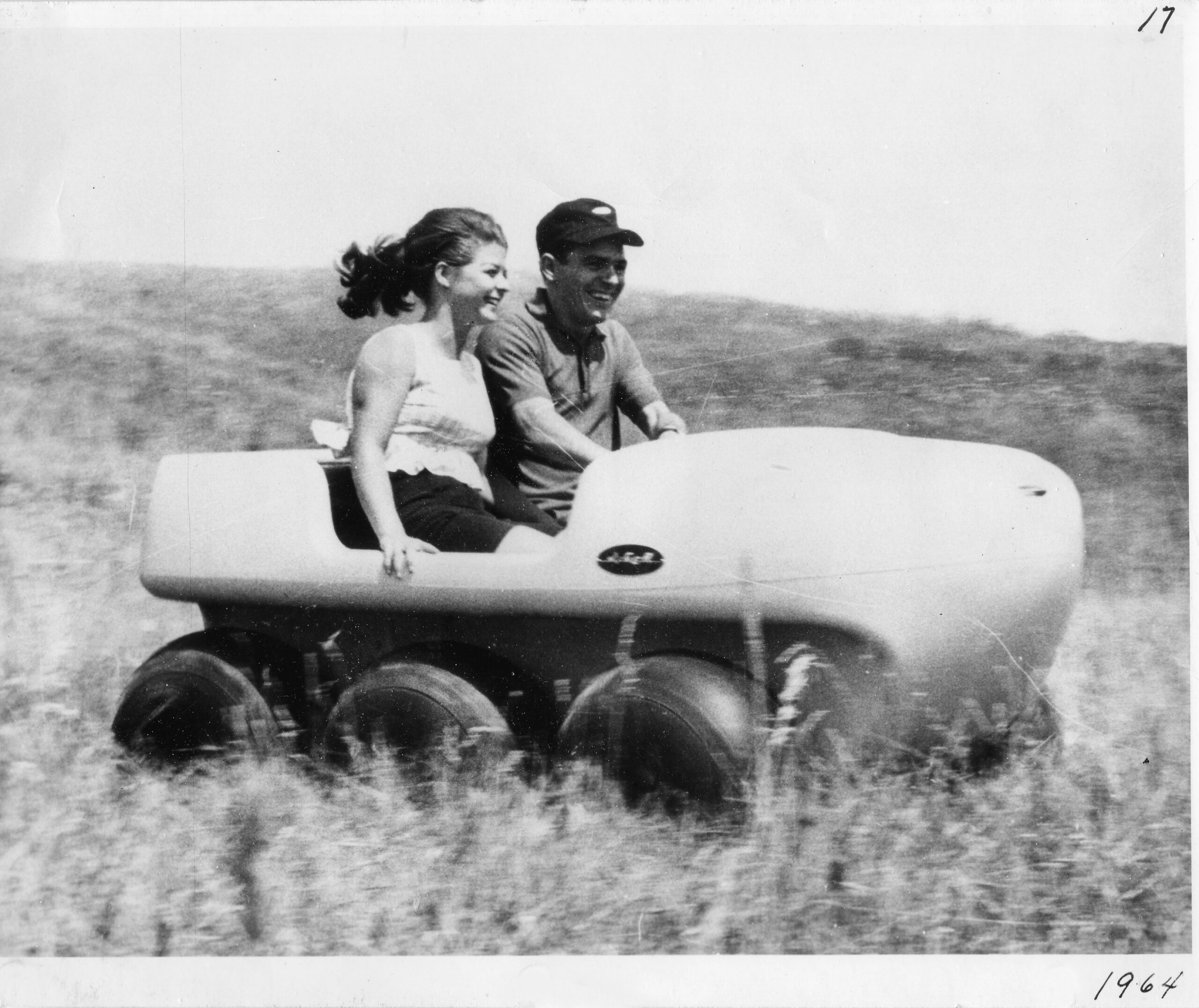When I began research for this series of articles on the evolution of off road recreational vehicles I had assumed, as most folks would, that the Honda ATC90 would be my first topic. To my surprise and delight I discovered a Canadian prequel that even has some parallels with the Avro Arrow story.
In 1959, almost twenty years before the ATC90, a gunsmith and tank enthusiast from Manitoba, John Gower/Rempel came up with a concept for an ultra light, all purpose “Go Anywhere Vehicle”. John’s concept, the “JiGeR”, involved a floating body capable of seating two persons on six low pressure tires driven by two engines, one powering the right, the other the left. What would truly set this vehicle apart would be the tires, soft enough to serve as the vehicles suspension, while also adding to the vehicles buoyancy.
After moving to Toronto and teaming up with a young Swiss engineer Fred Rohrer, they were able to bring his vision to reality. By 1960 the first prototype rolled out with twin 2 cycle chainsaw style engines, a belt and clutch system, and dual throttle controls providing the vehicles steering. The prototype body was constructed with chicken wire and body filler to show the vehicles design, with plans to use fiberglass should the vehicle go in to production. The prototype tires were Firestone Terra Tires, but later on John replaced these with his own designed lower pressure (2lbs, so low in fact, that you could inflate them by mouth) tires that were lighter still, and offered better vibration and terrain suppression. Early sales demonstrations depicted the vehicle and operator driving over a live human’s torso, causing little to no pain as the weight was so well spread out.
(Conspiracy Theory #1 – Some say that after JiGeR went broke, BF Goodrich, who had been contracted to make the custom low pressure JiGeR tires, went on to sell them as their own to anyone who wanted them)
Once in production with their own brand of JiGeR tires, the entire unit weighed less than 200 lbs, easily carried by two people, or lifted in to the back of a truck. These ATV’s were aimed at hunters, fishermen, and outdoorsmen. With the ability to easily traverse dirt, mud, water, and snow, there wasn’t really much to stop you. You can clearly see in the proving grounds video (youtube.com/goridingtv under liked videos) this machine was fast, maneuverable, unstoppable, and fun.
The first 29 units were built to order in the factory located on McLachlan Dr. in what is now Milton, Ontario, not far from the AVRO Arrow factory. The JiGeR was marked all over the world, with some help from cover articles in Popular Science, Hobby Magazine (Germany) and Mechanix Illustrated. By 1965 the JiGeR 152 model was in full mass production with almost 1900 units built. This model had evolved boasting single power plant offering more horsepower from its 148cc engine. The power train was completely redesigned to allow one motor to control both sets of drive wheels. (Conspiracy Theory #2 – Rumors spread of spies working in the JiGeR factory from Ontario Drive & Gear – later to become ARGO) Contracts with the US army were underway and the future seemed bright for JiGeR.
The JiGeR 197 was the last production model, with 2/3 more torque and 20% better fuel economy. A three speed transmission was added as well as flip up seats offering better access to the engine and storage. Almost 1300 JiGeR 197’s were produced.
In 1967 Andre J. Meyer, Jr, a member of the National Aeronautics and Space Administration wrote a letter to JiGeR after seeing one in a trade show in Houston Texas. Andre noted “the (JiGeR) vehicle may have some interesting features that could be useful to NASA”. Andre further stated “My group is presently evaluating a number of design concepts for a vehicle to enable astronauts to travel over the surface of the Moon”. John, eager to be involved in such an historic endeavor continued to correspond with NASA, however JiGeR’s demise would come before the engineers could complete their Lunar Rover Design.
April 1968 was the end of the JiGeR Corporation, and it’s Milton factory after producing some 3337 vehicles. Many were stunned at the announcement considering that the company had more orders than it could fill. Later that year an unnamed company backed by the Canadian Government re-licensed the trademark and began producing the Versatek Jiger. John was offered a position, but declined, although many other staff went on to the new company. Without John at the helm the design was altered, the units were heavier and more complex. Even after a last ditch marketing attempt to sell the units as a “Build it Yourself” kit, Versatek went bankrupt in 1971. (Conspiracy Theory #3 – The Canadian Federal Government, in an attempt to boost economic development in the eastern provinces had a hand in calling in the company’s debts, forcing them in to bankruptcy, only to re-open in Sydney Nova Scotia, not unlike it’s meddling in the affairs of the AVRO Arrow development)
With very few units surviving to this day, the JiGeR is in jeopardy of being forgotten. In fact following JiGeR some 60 companies worldwide came forward with amphibious all-terrain vehicles (AATV’s), but the only one to have stood the test of time is the ARGO, who still produce several models, and are the only “Go Anywhere Vehicle” produced. Today JiGeR is kept alive by those who have taken the time to find and restore the models from the 60’s. John Gower/Rempel’s grand children have taken on the family torch, Ryan, now living in Bala Ontario has one of the units that he hopes to restore, and Wayne who has several incomplete units, but hopes to restore one to its original state. Check out his website www.jiger.ca.

